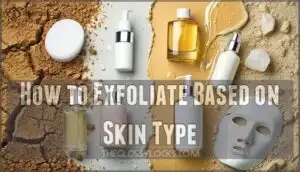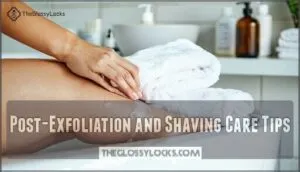This site is supported by our readers. We may earn a commission, at no cost to you, if you purchase through links.
 Your razor might be sharp, but if you’re skipping exfoliation, you’re setting yourself up for bumps, ingrown hairs, and that annoying stubble that reappears hours after shaving. Dead skin cells create a barrier that traps hair beneath the surface and prevents your razor from making clean contact with each strand.
Your razor might be sharp, but if you’re skipping exfoliation, you’re setting yourself up for bumps, ingrown hairs, and that annoying stubble that reappears hours after shaving. Dead skin cells create a barrier that traps hair beneath the surface and prevents your razor from making clean contact with each strand.
Exfoliating before shaving clears this barrier, lifting hairs away from the skin and creating a smooth canvas for your blade to glide across. The result isn’t just about aesthetics—it’s about preventing the painful inflammation and discoloration that can follow a poor shave.
Understanding how exfoliation transforms your shaving routine means knowing which methods work for your skin type and how to time them for maximum benefit.
Table Of Contents
Key Takeaways
- Exfoliating before shaving removes dead skin cells that trap hair beneath the surface, reducing ingrown hairs by up to 70% and razor bumps by 43% when done two to three times weekly.
- The practice creates a smoother canvas for your razor by lifting hairs away from the skin, improving blade glide by 40% and extending razor sharpness by 50% while preventing inflammation and discoloration.
- Choose your exfoliation method based on skin type—mechanical scrubs work well for oily, resilient skin, while chemical exfoliants with AHAs or BHAs are gentler for sensitive or dry skin, with darker skin tones benefiting most from mandelic acid to minimize hyperpigmentation risk.
- Proper timing and post-care matter as much as the exfoliation itself: always moisturize within minutes after shaving to repair your skin barrier, avoid over-exfoliating (which causes redness and sensitivity), and consult a dermatologist if irritation persists beyond two weeks.
Why Exfoliate Before Shaving?
Exfoliating before you shave isn’t just an extra step—it’s a major improvement for your skin. By removing dead cells and clearing the path for your razor, you set yourself up for smoother results and fewer post-shave problems.
Here’s what makes pre-shave exfoliation worth your time.
How Exfoliation Prepares Skin for Shaving
Exfoliating before you shave clears away dead skin cells that trap hair and block your razor’s path. This simple prep step makes everything work better:
- Skin cell removal unclogs hair follicles, letting each strand stand upright for easier cutting
- Hair follicle exposure prevents ingrown hairs by eliminating barriers that redirect growth beneath the surface
- Shaving cream effectiveness improves as active ingredients penetrate freshly exfoliated skin
- Razor glide improvement reduces dragging and tugging across bumpy, uneven texture
- Preventing irritation minimizes nicks and inflammation by creating a smoother canvas
Scientific Benefits for Women
Beyond the immediate smoothness, the science backs up real transformations beneath the surface. Pre-shave exfoliation boosts collagen production and accelerates cell turnover, visibly reducing fine lines over just 12 weeks.
Your skin health improves as barrier function strengthens and cytokine levels drop, meaning less inflammation post-shave. Plus, product absorption jumps by up to 28%, so moisturizers and serums penetrate deeper.
The benefits of exfoliating extend to skin renewal at a cellular level, making this simple step a powerhouse for long-term radiance. The market is seeing growth, with the market expanding steadily through 2033.
Ingrown Hairs and Razor Bump Reduction
The real win comes when you look at hair follicle health. Exfoliating before shaving cuts ingrown hairs by up to 70% and drops razor bumps by 43%. That’s because exfoliation clears away dead skin cells, preventing hair from getting trapped as it grows back.
For best results, stick to two or three sessions per week—this frequency keeps your bikini line and underarms smooth without overdoing it. Exfoliating helps by clearing away dead skin and freeing hairs, which is why exfoliating helps before they become ingrown.
Pair your shaving technique with gentle body exfoliation, and you’ll notice fewer bumps and calmer skin within weeks.
Achieving a Closer, Smoother Shave
Want your razor to glide effortlessly instead of tugging at your skin? Exfoliation makes that happen.
When you exfoliate before shaving, you’re setting up your skin for the cleanest cut possible.
- Razor glide improves by 40%, letting blades cut closer without dragging
- Blade sharpness lasts 50% longer because dead skin won’t clog your razor
- Shave cream absorbs better on freshly exfoliated skin
- Skin irritation drops considerably when you remove surface debris first
- Ingrown hairs decrease, keeping your skin consistently smooth
Exfoliating clears the path for a cleaner cut every time.
Choosing The Right Exfoliation Method
Exfoliation isn’t one-size-fits-all. Your best option comes down to what your skin needs and what feels right to you.
Knowing how mechanical and chemical methods differ gives you a solid starting point for choosing.
We’ll walk through both methods and include a few easy DIY recipes worth trying.
Mechanical Vs. Chemical Exfoliation
Both methods work, but they tackle dead skin differently. Mechanical exfoliation uses physical scrubs or tools to manually slough off dead cells.
Chemical exfoliation takes a different route—acids like AHAs or BHAs dissolve them instead.
Here’s how they compare:
| Factor | Mechanical | Chemical |
|---|---|---|
| Technique gentleness factor | Scrub particle size and tool material impact vary; can be abrasive | Acid concentration levels determine mildness; generally gentler |
| Long-term effects | Risk of micro-tears with aggressive use | Promotes cell turnover without surface trauma |
| Best for | Oily, resilient skin | Sensitive, dry skin types |
Both manual exfoliation and chemical exfoliation work effectively before shaving—your skin type determines which suits you best.
DIY Exfoliation Recipes
Creating your own pre-shave exfoliant at home doesn’t require fancy ingredients—just a few kitchen staples can deliver results that rival store-bought formulas. Try these DIY scrubs using natural ingredients:
- Coffee grounds + coconut oil – energizes skin while buffing away dead cells
- Brown sugar scrub – gentle enough for sensitive areas like bikini lines
- Oatmeal + honey mix – soothes while exfoliating dry skin
- Sea salt + olive oil – combats rough patches on legs
- Baking soda paste – quick chemical-mechanical combo for oily skin
Store homemade scrubs in airtight containers and use within two weeks for freshness.
How to Exfoliate Based on Skin Type
Your skin is unique—so your exfoliation routine should be too. The right method and frequency depend entirely on your skin type, helping you get visible results without the redness or irritation.
Let’s break down what works best for sensitive, dry, oily, combination, and darker skin.
Sensitive Skin Considerations
If your skin is prone to react or redden easily, exfoliating before shaving requires extra caution to avoid triggering irritation or inflammation.
Choose gentle exfoliants containing soothing ingredients like colloidal oatmeal or chamomile, and always perform patch testing on a small area first.
Apply minimal pressure during exfoliation, watch for irritation signs such as stinging or burning, and limit sessions to once weekly until your sensitive skin builds tolerance.
Dry, Oily, and Combination Skin Tips
The way your skin produces oil plays a big role in choosing the right exfoliant and timing your pre-shave routine.
- Dry skin benefits from AHA-based exfoliants that boost hydration levels while sloughing off dead cells—think lactic or glycolic acid paired with product layering of moisturizers.
- Oily skin responds well to BHA exfoliants for sebum control, particularly salicylic acid, which penetrates pores and prevents clogged follicles.
- Combination skin requires T-zone balance by applying stronger exfoliants where oil accumulates and gentler formulas on drier areas.
Adjust your exfoliation frequency with seasonal changes—drier winter months may need less frequent sessions.
Exfoliating for Darker Skin Tones
Darker skin tones are more vulnerable to post-inflammatory hyperpigmentation, with individuals of Fitzpatrick types IV–VI experiencing up to twice the risk compared to lighter skin.
That’s why choosing gentler chemical exfoliants like mandelic acid or enzyme-based formulas is important—they reduce irritation by over 50% while safely addressing hyperpigmentation and ingrown hairs.
Stick to twice-weekly exfoliation, follow with ceramide-rich barrier management products, and always consult dermatologists before using at-home peels stronger than 10%.
Step-by-Step Guide to Exfoliating Before Shaving
Exfoliating before you shave doesn’t have to feel complicated. The key is knowing how to prep your skin properly, choosing the right technique for each area, and timing it all correctly.
Here’s what you need to know to get smooth, bump-free skin every time.
Prepping Your Skin
Before you reach for your razor, start with clean, slightly damp skin—it’s the foundation that makes all the difference between a shave that glides and one that tugs.
Rinse with lukewarm water, then apply a warm compress for about 30 seconds to soften hair follicles and open pores.
This hydration step preps your skin for effective exfoliation while minimizing irritation across all skin types.
Exfoliation Techniques for Different Body Parts
Once your skin is prepped and ready, tailor your exfoliation approach to match the unique needs of each area you’re shaving. Legs can withstand firmer pressure, while underarms and bikini zones demand a lighter touch.
Use circular motions with a body scrub or mechanical exfoliation tool on legs and arms, applying moderate pressure.
For underarm exfoliation and bikini exfoliation, switch to gentler chemical exfoliation or soft cloths to prevent irritation in these delicate areas.
Frequency and Timing Recommendations
Getting the technique right is one thing, but how often and when you exfoliate makes the difference between healthy skin and irritation.
For most skin types, exfoliating two to three times weekly prevents skin irritation while maintaining clear pores. Adjust your shaving schedule and skin care routine based on skin sensitivity—oily skin tolerates more frequent exfoliation, while sensitive types benefit from weekend exfoliation only.
Seasonal adjustments matter too, since winter dryness often requires reduced frequency to protect your skin’s barrier.
Post-Exfoliation and Shaving Care Tips
Once you’ve exfoliated and shaved, your skin needs proper attention to stay healthy and comfortable. The right post-care routine helps you avoid irritation, maintain smoothness, and protect against common problems like razor burn or dryness.
Here’s how to keep your skin smooth and healthy after shaving.
Moisturizing and Soothing The Skin
After you’ve exfoliated and shaved, your skin isn’t just asking for moisture—it’s practically begging for it. Hydration importance can’t be overstated—your skin barrier has been compromised and needs barrier repair.
Apply a moisturizer with soothing ingredients like aloe or ceramides within minutes. This post-exfoliation skin care step locks in skin hydration and prevents irritation.
Avoiding Common Mistakes and Risks
Exfoliation and shaving both work wonders for your skin, but push too hard or use the wrong approach and you’ll pay for it.
Watch for red flags like redness, stinging, or that tight, irritated feeling that means your skin barrier’s taken a hit.
Don’t exfoliate daily—twice weekly is enough for most skin types. Skip exfoliation if you’re experiencing product sensitivity or active skin irritation.
Avoid sun exposure immediately after, as risks of exfoliation increase with UV damage, raising scarring risks and infection prevention concerns, especially for sensitive skin.
When to Consult a Dermatologist
How do you know it’s time to see a specialist about exfoliation or shaving issues? Irritation that sticks around for more than two weeks is your cue—especially if you have sensitive or acne-prone skin.
Book a dermatologist appointment if you’re dealing with:
- Recurring bumps, burns, or darkened patches that won’t fade
- Severe symptoms like swelling, crusting, or infection signs
- Underlying factors such as medications affecting skin sensitivity
- Complications affecting your face, where scarring risk increases
Safe practices matter, but professional guidance ensures your skin type and skin conditions get proper care.
Frequently Asked Questions (FAQs)
Can exfoliation help prevent post-shave irritation?
Yes, exfoliation helps prevent post-shave irritation. Removing dead skin cells reduces friction and allows smoother razor glides, minimizing skin sensitivity.
Proper exfoliating decreases ingrown hairs and inflammation—common irritation causes—while improving hydration and product ingredient absorption for healthier skin care routines.
What ingredients should women avoid when exfoliating?
Some think all exfoliating ingredients suit every skin, but that’s not true. Avoid irritating fragrances, harsh scrubs, high alcohol, abrasive beads, and comedogenic oils when exfoliating.
Even beneficial alpha hydroxy acids, beta hydroxy acids, salicylic acid, and glycolic acid can irritate sensitive skin.
Is exfoliating safe during pregnancy or breastfeeding?
Most exfoliation methods are safe during pregnancy and breastfeeding, but you’ll want to stick with gentle mechanical exfoliants.
Chemical exfoliation raises concerns about skin care ingredient absorption, though topical use of AHAs and BHAs in low concentrations generally poses minimal risk.
If you have sensitive skin or specific concerns, consult your dermatologist for individual recommendations.
How does water temperature affect exfoliation results?
Warm water opens pores and softens skin by 30%, enhancing exfoliation effectiveness. Lukewarm temperatures work best—hot water strips natural oils, while cold water limits exfoliant activation.
Match water temperature to your skin’s sensitivity for best results.
Can over-exfoliating damage skins natural protective barrier?
Over-exfoliating disrupts barrier function, leading to redness, irritation, and increased sensitivity.
Your skin loses moisture more easily, risking dehydration and long-term skin health issues.
Exfoliate gently to protect your skin care routine’s effectiveness.
Conclusion
Exfoliation is like prepping your canvas before painting—skip this step, and nothing else works the way it should.
The exfoliating before shaving benefits women experience extend far beyond smoother skin; they include fewer ingrown hairs, reduced inflammation, and lasting results that make every shave count.
Choose your method based on your skin type, stick to a consistent routine, and pair exfoliation with proper aftercare. Your skin will reward you with the close, bump-free shave you’ve been chasing all along.
- https://dermatologyofct.com/achieve-smooth-healthy-skin-a-womans-guide-to-shaving/
- https://vitalskinderm.com/blog/how-dermatologists-say-you-should-be-shaving/
- https://www.reddit.com/r/LifeProTips/comments/1hffhab/lpt_exfoliating_before_hair_removal_makes_a_huge/
- https://www.healthshots.com/beauty/skin-care/exfoliation-before-and-after-hair-removal/
- https://www.katesomerville.com/blogs/news/should-i-use-body-scrub-before-or-after-shaving









